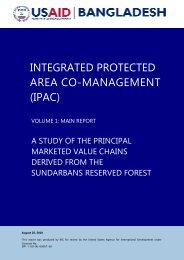Child Equity Atlas - BIDS
Child Equity Atlas - BIDS
Child Equity Atlas - BIDS
You also want an ePaper? Increase the reach of your titles
YUMPU automatically turns print PDFs into web optimized ePapers that Google loves.
<strong>Child</strong> <strong>Equity</strong> <strong>Atlas</strong><br />
5.3 Access to Electricity<br />
5.3.1 Access to electricity in this <strong>Atlas</strong>, derived from<br />
the census, refers to having electricity connections<br />
in households. Data show that households’ access<br />
to electricity has increased by 24.7 percentage<br />
points in the last 10 years. In 2011, 56.1 per<br />
cent of households in the country had access<br />
to electricity connection while the proportion<br />
was only 31.4 per cent in 2001. Maps 5.5 and 5.6<br />
show the district-wise distribution of electricity<br />
connection in households between 2001 and<br />
2011 respectively. Clearly, access to electricity is<br />
far from being uniform throughout the country.<br />
The proportion of households without electricity<br />
connection in rural areas is much higher (52.8 per<br />
cent) than in urban areas (13.6 per cent).<br />
5.3.2 Among the administrative divisions,<br />
the proportion of households without access to<br />
electricity is higher in Rangpur (68.1 per cent) and<br />
Barisal (60.8 per cent) divisions than in Chittagong<br />
(36.3 per cent) and Dhaka (33 per cent) divisions<br />
(Figure 5.3). The district and upazila Maps 5.6 and<br />
5.7 illustrate the spatial distribution of households<br />
having no electricity connection. The Maps show that<br />
households in the Northern, North-Central, Southern<br />
and South-Eastern regions of the country have lesser<br />
access to electricity compared to the other regions of<br />
the country. Table 5.4 shows the five best and worst<br />
performing districts without access to electricity.<br />
% of households<br />
Figure 5.3: Percentage of households having<br />
no electricity connection by administrative<br />
divisions and rural and urban areas, 2011<br />
80.0<br />
Total Rural Urban 73.0<br />
67.5<br />
68.1<br />
70.0 60.8<br />
60.0<br />
54.2<br />
56.2<br />
50.3<br />
50.0<br />
43.6 45.4<br />
48.6<br />
50.0<br />
52.8<br />
44. 5<br />
43.9<br />
40.0<br />
36.3 33.0<br />
33.6<br />
25.3<br />
30.0<br />
21.3<br />
17.8<br />
20.0<br />
14.2<br />
6.8<br />
10.0<br />
15.7<br />
13.6<br />
0.0<br />
Barisal<br />
Dhaka<br />
Khulna<br />
Table 5.4: Proportion of households without<br />
electricity connection: Best and worst districts,<br />
Bangladesh 2011<br />
Srl. Best districts Worst districts<br />
Rajshahi<br />
Rangpur<br />
Sylhet<br />
Total<br />
District % District %<br />
1. Dhaka 3.0 Lalmonirhat 79.9<br />
2. Narayanganj 4.7 Kurigram 79.2<br />
3. Munshiganj 9.9 Bhola 74.1<br />
4. Gazipur 16.0 Panchagarh 73.0<br />
5. Chittagong 20.9 Bandarban 71.8<br />
Bangladesh: 43.9%<br />
Photo : Ibrahim Khan Moni<br />
70














